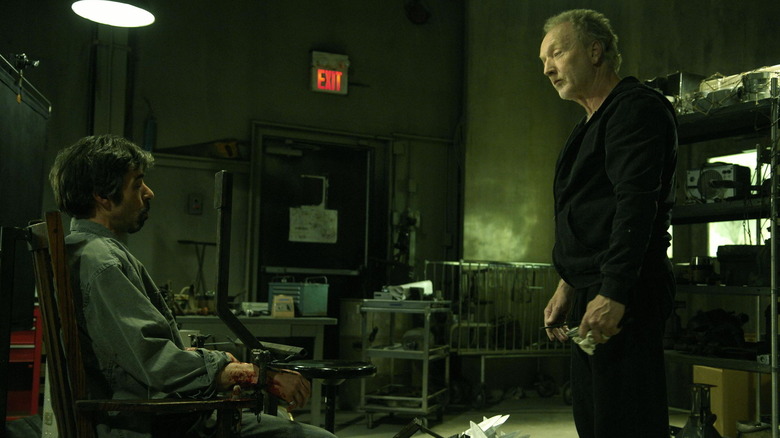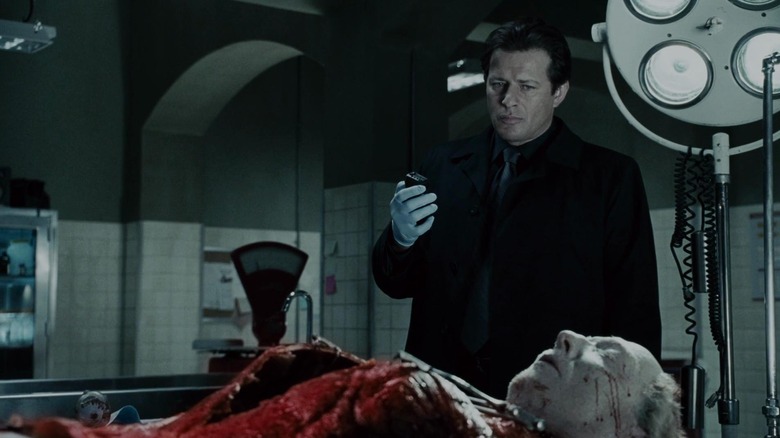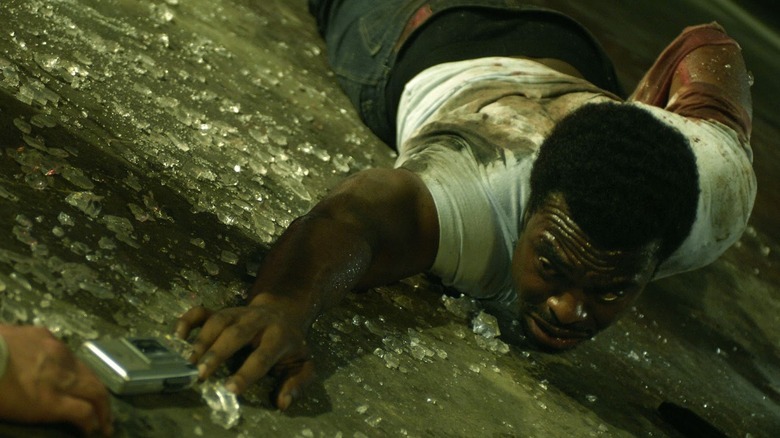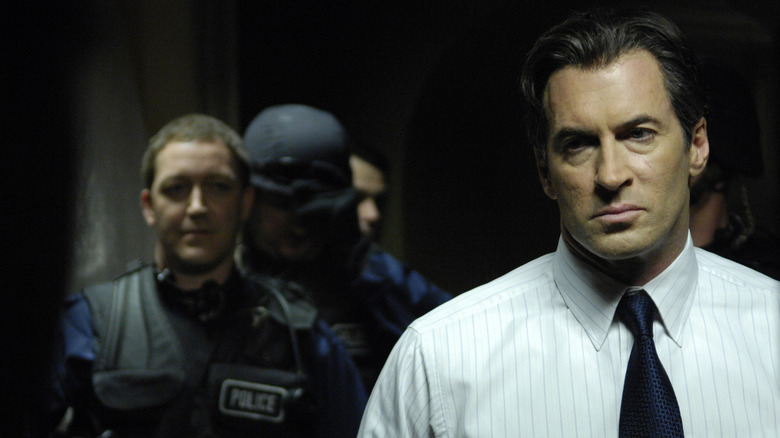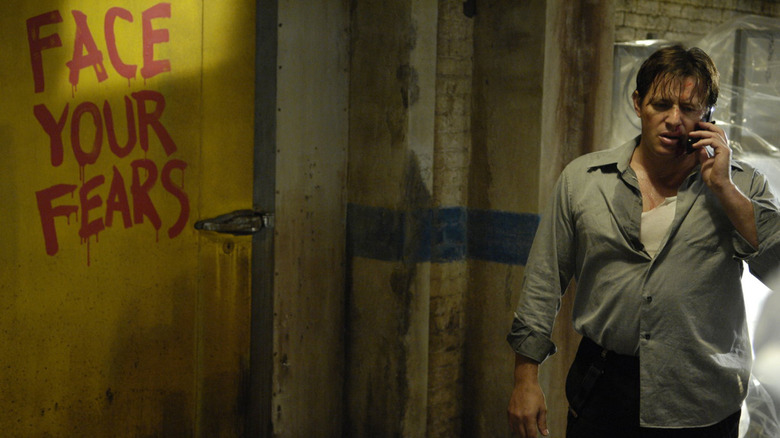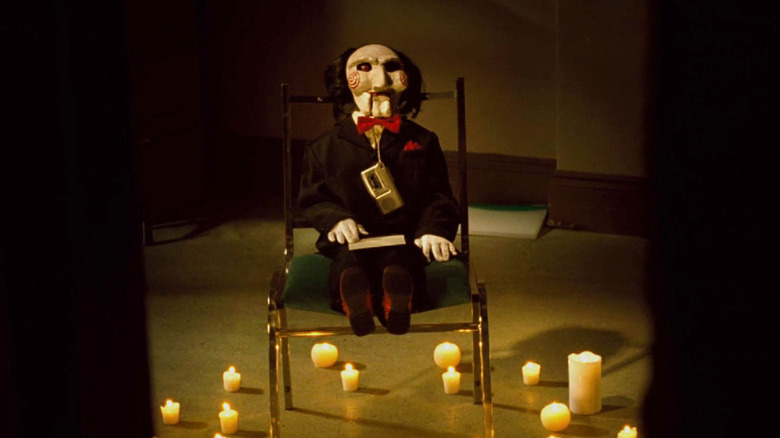Saw 4 Ending Explained: Save As I Save
In 2007, the "Saw" franchise took a very big swing with the aim of setting the movies up for years to come. Darren Lynn Bousman returned to the director's chair for the third time with "Saw IV," which aimed to move beyond Tobin Bell's John Kramer by giving Jigsaw a path forward without the man who started these twisted, bloody games in the first place. The film's ending not only offers one of the biggest twists in the entire series — but also one of the most important. Divorced of everything that came after, it was a big, bold, critical change in direction.
For those who may need a brief refresher, Bell plays the central figure of the films as John Kramer, aka Jigsaw, a man with incurable cancer who dedicates himself to "saving" people in a way that he sees fit. He selects people who are ungrateful for the life they have and makes them play deadly games that will give them a newfound respect for being alive. He technically doesn't kill people directly, but he puts them in precarious "live or die" situations that, at best, will leave them gravely wounded. The cancer got the best of Kramer at the end of "Saw III," leaving the franchise without a killer. Or so we thought!
Kramer was actually training more than one replacement to carry on his legacy. "Saw IV" revealed that Detective Hoffman (Costas Mandylor) had been working with Kramer for some time, meaning that the death of Amanda (Shawnee Smith) during the events of "Saw III" was not the end of Jigsaw's games. But the timeline got a little messy along the way, and a whole lot happened in order to set the stage for "Saw V" and beyond. So let's dive into the ending, what it means, what it did for the franchise, and seek to offer a better understanding of the film overall.
A brief recap of Saw IV
"Saw IV" opens with the autopsy of John Kramer, where a cassette tape is pulled out of his stomach. Detective Hoffman plays the tape, which warns that the gory games will continue. Cut to SWAT officer Daniel Rigg (Lyriq Bent) who is forced to play a deadly game in order to find two missing colleagues: Hoffman and, most importantly, Eric Matthews (Donnie Wahlberg) who was thought to be dead after what happened to him during the events of "Saw II."
A pair of FBI profilers — Agent Strahm (Scott Patterson) and Agent Perez (Athena Karkanis) — trail Rigg as they begin to suspect that he might be Jigsaw's mystery accomplice. All the while, Bousman pulls back the curtain on the past as we learn about Kramer's past in a series of flashbacks. Not only does this allow Bell to be in the movie, but it helps the viewer better understand Kramer's motivations. This is crucial in building a case for the movie's big reveal. The viewer needs to understand John, just as his potential proteges need to understand.
For much of the movie, we believe that Rigg is being groomed to take over for Jigsaw as his game is all about setting aside his obsession with the killer and, instead, understanding why these people are being selected for the games. For someone to become the new Jigsaw, they must see the world the way he sees it.
Through the flashbacks, we are treated to a thorough lesson on John Kramer's philosophy. The idea is that John wants people to truly be saved in a meaningful way. Throwing people in prison doesn't save them. Putting them through social programs doesn't save them. Killing them outright doesn't save them. As he sees it, if someone survives when truly faced with death, they will "save" themselves. He wants Rigg (or so it seems) to save the way that he saves.
The ending of Saw IV and Jigsaw's big twist
For most of the movie, we're led to believe that Hoffman is chasing down John's demons after his death. He's still the "good" guy and Rigg is at serious risk of becoming the "bad" guy. After all, how can Hoffman be the bad guy when he's at risk of dying as part of John's posthumous game? While Matthews stands atop a block of melting ice, Hoffman awaits electrocution once the ice turns to water. Their survival is dependent on Rigg accepting Jigsaw's lesson and just letting the whole thing go.
Rigg's game relies on him not opening the door to where Matthews and Hoffman are being held until after his timer expires. Rigg instead opens the door with just a second to spare and, as was explained by Jigsaw survivor Art (Louis Ferreira), Matthews' head is crushed brutally by two huge blocks of ice. He shot Rigg but it didn't matter. Rigg then shoots Art in the head. It becomes a total s*** show of blood and bullets.
All the while, in another room, Strahm is seemingly hot on Rigg's tail but the room he enters contains Jeff (Angus Macfadyen), who is standing by John's freshly dead body. One of the two big twists here is that the events of "Saw IV" actually take place right alongside the events of "Saw III," with the autopsy scene in the beginning actually serving as more of an ending. That means Hoffman survived the game and was not actually shocked to death. That's because he was actually orchestrating the game and taking part in it, mirroring what John Kramer did in the first "Saw."
What we come to find is that Hoffman has already been converted to the ways of Jigsaw. He shuts Rigg in the room before heading off to leave Strahm for dead as well. Hoffman has been helping John for several movies now. John was the brain and Hoffman was the brawn.
Setting the table for the future
The whole purpose of "Saw IV," in light of the big twist, is to set the table for what would come in the ensuing films. It was all about giving the franchise a future without John Kramer. Sort of. Not only do we have Hoffman becoming the central figure as the heir apparent to Kramer, but we're also introduced to Strahm and Perez, who are also key figures in the films that would immediately follow, particularly "Saw V" and "Saw VI." We also get a lot more of Jill (Betsy Russell), John's ex-wife who becomes a crucial figure in the films that follow. She somewhat reluctantly helps to carry on his legacy. Again, another way forward without the original Jigsaw.
It took a lot of twisting the timeline and clever plotting by writers Patrick Melton and Marcus Dunstan, but they managed to give the series a new Jigsaw killer that actually made sense. It truly seemed like things were going to end when Amanda was dispatched in "Saw III" as she was being groomed to take the mantle. All the while, Hoffman was looming large in the background, hiding in plain sight. It was a bold and necessary move.
This wasn't a situation like "A Nightmare on Elm Street" or "Friday the 13th" where the studio could just keep bringing Freddy or Jason back to life. There is no supernatural element at play in the "Saw" films (at least not yet). John Kramer was just an old man with a twisted view of humanity who wanted to try and enact change in his way before he died. And canonically, he died in 2006. The only way, seemingly, to continue on without him was to find someone else to carry on his legacy. That man, for a time, was Detective Hoffman.
Trying (and failing) to move away from John Kramer
What Bousman, Melton, and Dunstan tried to do with "Saw IV" was move beyond John Kramer and give the franchise a future for years to come. In some way, they accomplished that as the series now includes a total of ten movies. Be that as it may, Tobin Bell has been a part of the proceedings in some way or another the whole way through, largely through increasingly convoluted flashbacks. 2017's "Jigsaw" found a particularly wacky way to bring Bell back despite having been dead within the canon of the movies for more than a decade.
2021's "Jigsaw," which saw Bousman returning to direct an installment in the series for the first time since "Saw IV," was the first truly earnest attempt to do a "Saw" movie without John Kramer in it. The movie was only a modest success and, as a result, "Saw X" is going violently in the other direction, with Bell returning as the lead character in a prequel set between the events of "Saw" and "Saw II." It's a pretty wild thing to do, considering that we're talking about using the same actor who is now nearly 20 years older than he was when those first movies were made.
No matter how hard the filmmakers tried to move away from Jigsaw, his shadow has loomed large as a presence over these movies for their entire existence. Even though he is — or perhaps was — merely a human being, John Kramer is immortal within this universe. In some way, by setting up Hoffman as his successor, "Saw IV" cemented Jigsaw as an unkillable horror icon. The idea was bigger than the man. It just so happens that the man is wildly popular and helps sell a lot of tickets. So, Lionsgate has found ways to get Bell back for more despite the increasingly improbable nature of it all.
Director Darren Lynn Bousman's thoughts on Saw IV
"Saw V," which is widely considered to be one of the lower points in the franchise, sees Hoffman trying to frame Strahm for the Jigsaw murders. It sets up an entirely new plot that carries on for several movies until Lionsgate hit the pause button on the series following the lackluster response to 2010's "Saw 3D," aka "Saw: The Final Chapter."
For his part, Bousman stepped away from the series to go make movies like "Repo: The Genetic Opera" and "The Devil's Carnival," having no say in the Hoffman storyline beyond setting the whole thing up. On his website, Bousman discussed "Saw IV" and explained that he feared that the franchise could jump the shark. The whole idea was to bring something fresh to the table without going totally off the rails. Here's what he had to say about it:
"I am a huge horror fan ... In fact, I would consider myself a horror fan, over a horror director. That being said, I knew as a horror fan — this franchise could easily jump the shark. We had to bring something new and original to Saw. But what? The story for 'Saw IV' was a battle right until the very end. For the first time in the Saw universe, I was scared ... No — terrified! What if 'Saw IV' didn't work ... What if the twist was lame? What if? Luckily, I had an amazing crew and producing team behind me."
Whatever came after — the good, the bad, and the ugly of it all — was only possible because of what Bousman did in "Saw IV." It gave the series new life after "Saw III" made it seem like things were going to soon come to an end. Bousman — both with this movie and "Spiral: From the Book of Saw" — tried his damndest to find a new direction for the series.
